
The Solar-Terrestrial Centre of Excellence (STCE) is a collaborative network of the Belgian Institute for Space Aeronomy, the Royal Observatory of Belgium and the Royal Meteorological Institute of Belgium.
 |
Published by the STCE - this issue : 18 Oct 2013. The Solar-Terrestrial Centre of Excellence (STCE) is a collaborative network of the Belgian Institute for Space Aeronomy, the Royal Observatory of Belgium and the Royal Meteorological Institute of Belgium. |
| Archive of the newsletters | Subscribe to this newsletter by mail |
On 9, 11 and 13 October, the Sun produced an M-class solar flare each day. These three medium-sized eruptions were the first since mid-August, ending a nearly comatose period of solar activity.
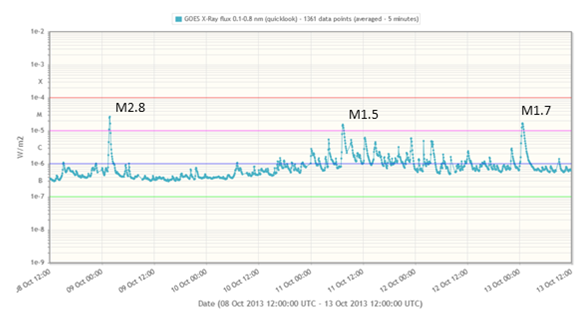
The 9 October M2.8 flare lasted 33 minutes and peaked at 01:48UT. It originated in sunspot group NOAA 1865. As this sunspot group was still close to the southeastern limb, it was difficult to predict the (strength of the) eruption due to the very oblique angle space weather forecasters had at that moment. The SDO-images underneath show the sunspot groups in visual light, as well as through filters near 80,000 degrees (AIA304, middle) and several million degrees (AIA 131, right). The three images were taken near the time of maximum brightness in x-rays.

The 11 October M1.5 flare lasted 44 minutes and peaked at 07:25UT. It originated in a sunspot group which was at the time still well behind the northeastern solar limb. This suggests that the true strength of the eruption was probably higher than the measured M1.5.
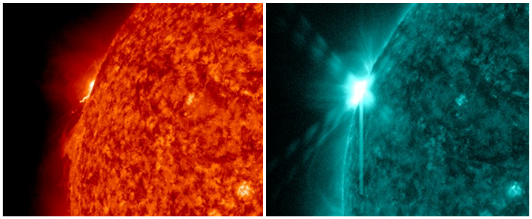
Both flares were visible from the STEREO-B spacecraft, which is currently well on the other side of the Sun as seen from Earth. In particular the two small, transient coronal holes from the 11 October event are obvious as dark patches to the south of the bright active region. These holes are the result from material being flung through the corona during the eruption. By the end of the day, these temporary punctures had disappeared.
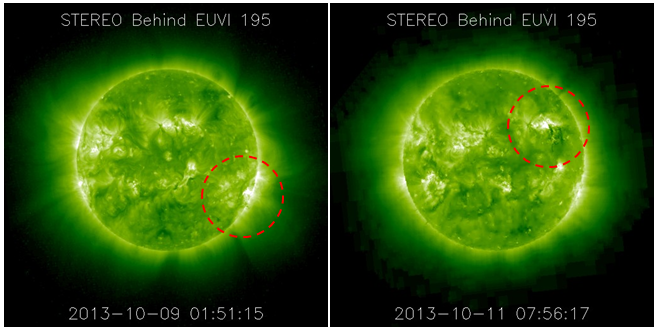
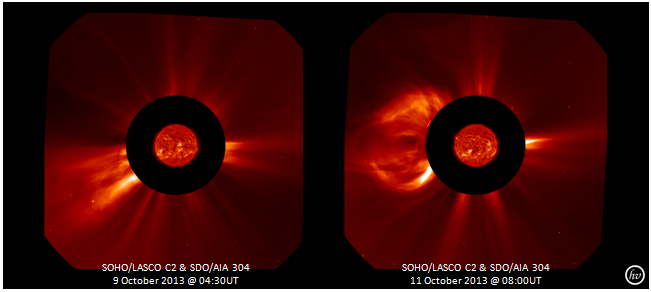
Both eruptions were accompanied by coronal mass ejections (CMEs), but none was Earth directed. The 9 October one was not very impressive, in contrast to the CME from 11 October (see SOHO images above). The latter was halo-like as seen by both the SOHO and the STEREO-B spacecraft. Due to the position of the active region at the time of the explosion, the CME was directed towards STEREO-B, and away from Earth. This is called a backside halo CME. See images underneath by SOHO (left, 10:18UT) and STEREO-B (right, 10:10UT).
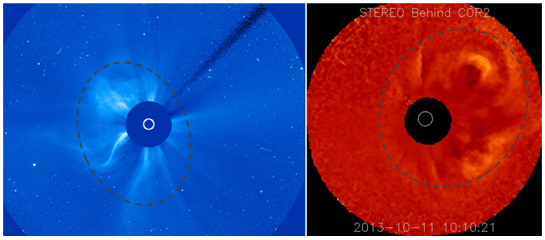
The 13 October M1.7 flare peaked at 00:43UT and took also place in active region NOAA 1865. Seen in the red light of Hydrogen-alpha, it concerned a parallel ribbon flare running east-to-west along the magnetic neutral line of the sunspot group. See the visual image and magnetogram from SDO (resp. left and middle), and the H-alpha image by GONG (right). The flaring region is at the bottom left in each image. Clearly, the upper ribbon is hovering over the black polarity (inward oriented magnetic field) sunspots, while the lower ribbon is hovering over the opposite, white polarity (outward oriented) sunspots. The CME associated to this eruption was mainly directed towards the south of the Earth.

Credits - Images were taken from the GONG H-alpha network (http://halpha.nso.edu/ ), SDO (http://sdo.gsfc.nasa.gov/ ), STEREO-B (http://stereo.gsfc.nasa.gov/ ) and SOHO (http://sohowww.nascom.nasa.gov/ ).
Surfing from the solar surface through the solar atmosphere is possible nowadays. The online tool Helioviewer brings the sun and its inner heliosphere to your home computer. Helioviewer is an intuitive interface and novel technology that presents heterogeneous solar physics data at one glance.
Due to the partial shutdown of the US federal government, the main Helioviewer server at NASA-GSFC which provides helioviewer.org and the application JHelioviewer has been inaccessible since Oct 1 2013. There is a plan B: users of Helioviewer services can switch to a newly created redundant server at the Royal Observatory of Belgium. This server provides a growing number of data sources, selected for their use in real-time space weather monitoring.
For the helioviewer.org service, please visit http://swhv.oma.be/helioviewer/
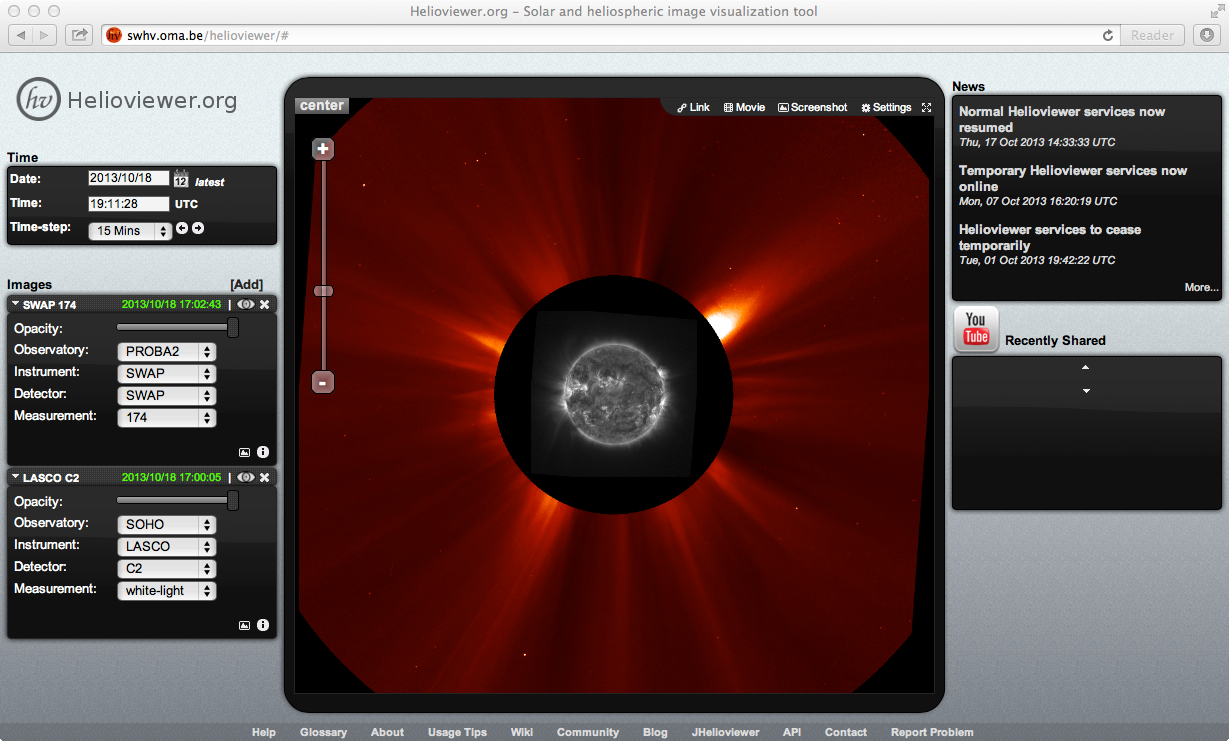
The ionosphere was disturbed in the northern part of Europe during the night of the 8th of October. During the day of the 9th of October, a strong increase of Total Electron Content (TEC) occurred in the southern part until 10:00 AM before depletion, whereas in the northern part only a decrease of TEC w.r.t. the median of the 15 previous days was observed. For more info about the TEC: http://gnss.be/ionosphere_tutorial.php#x2-30000
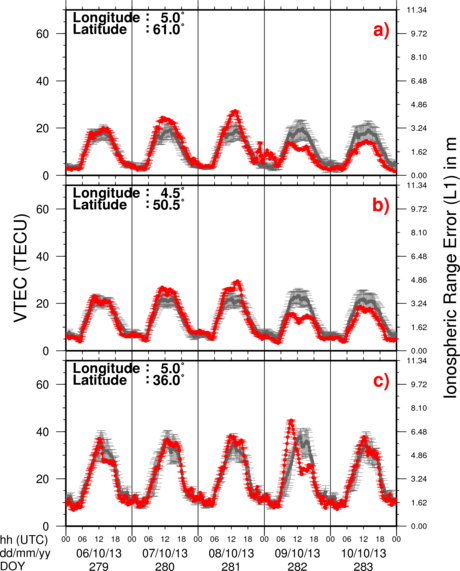
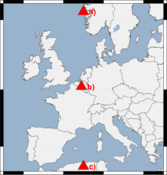
These ionospheric disturbances were most probably associated with the halo CME observed on the sun on the 6th of October which was mentioned in the space weather bulletin of October 7: A C1.1 flare occurred on October 6, in Catania region 95, east of NOAA AR 1859. Peaking at 1424 UT, it was associated with a dimming and a faint halo CME observed in LASCO C2. An interplanetary shock wave was indeed detected by ACE and SOHO/CELIAS around 20:00 UT on October 8. The solar wind speed in the post-shock solar wind flow reached 700 km/s, and the interplanetary magnetic field (IMF) magnitude reached 35 nT, with brief intervals of strong (up to -20 nT) southward fields.
Solar activity has been eruptive to active in the past week with a series of C and M flares. Two active regions, NOAA AR 1861 and NOAA AR 1865 were the most prominent regions, with complex magnetic configurations and moderate to fast evolution. The picture on the left is taken by the EUV imager SWAP onboard of PROBA2: the bright parts are active regions and have a NOAA number. The picture on the right is a magnetogram from the HMI instrument onboard of SDO. A magnetogram shows how strong the magnetic field is at the surface of the sun: black/white indicates that there is a strong inward/outward pointing magnetic field. The black/white areas correspond with the bright active regions.
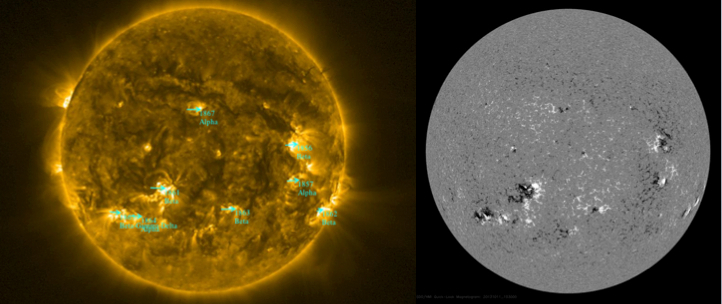
Geomagnetic activity was quiet most of the week, except on late October 8, when minor storm conditions (Kp=5) were observed at planetary levels, decreasing to active conditions (Kp=4) by October 9 mid-day. The cause of this disturbed conditions was the much-sooner-than-expected arrival of an interplanetary shock, linked to an ICME. Interplanetary measurements by the ACE spacecraft showed an elevated solar wind speed of 700 km/s, strong compression of the magnetic field up to 35 nT and fair negative excursions of the Bz component (down to -20 nT). The graphs below show shock as a sharp increase in wind speed, density and total magnetic field between 19 and 20UT. The source of this event was a CME, which occurred on October 6.
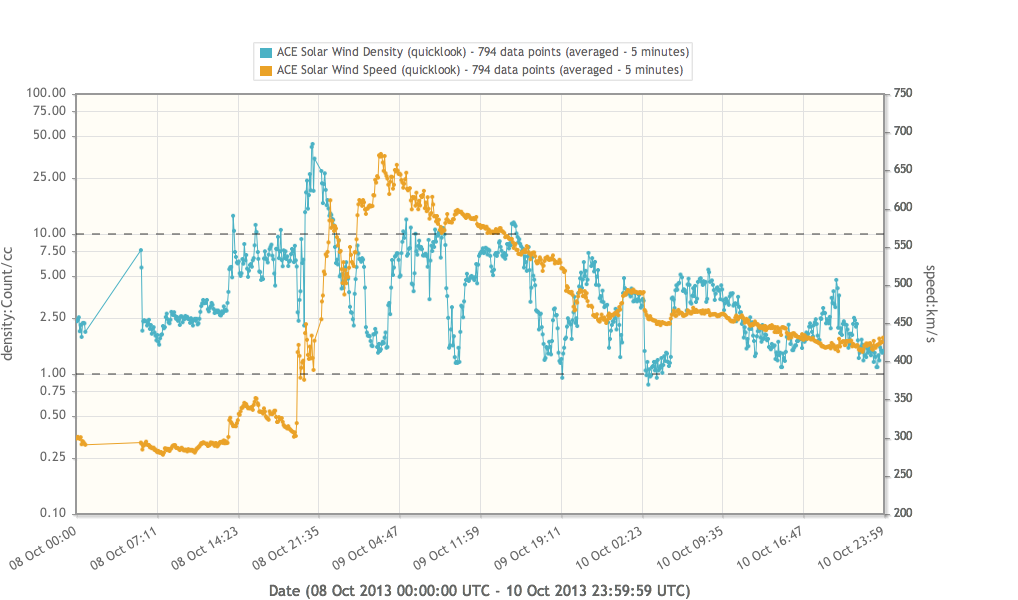
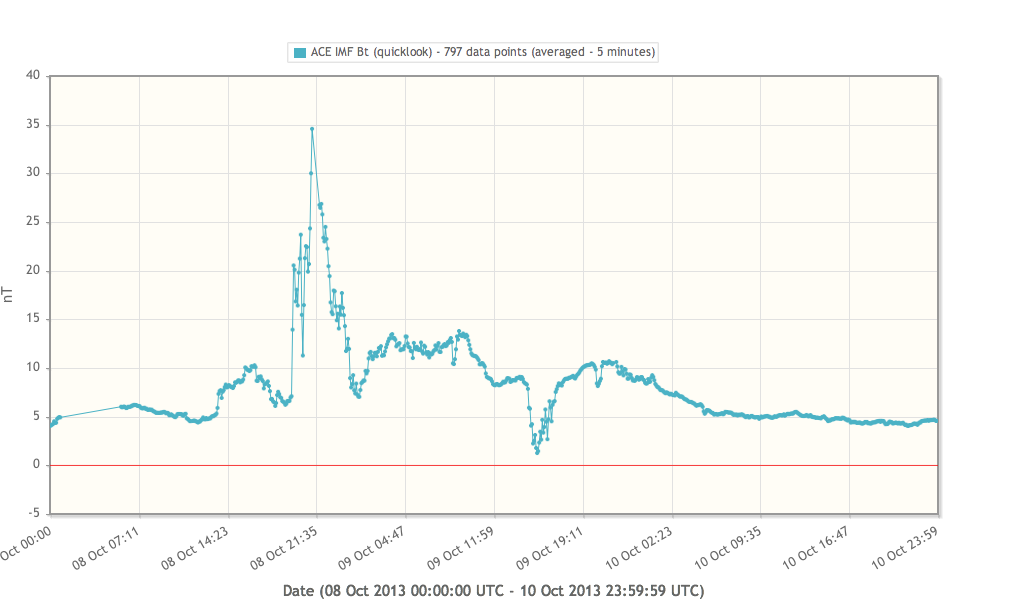
| DAY | BEGIN | MAX | END | LOC | XRAY | OP | 10CM | TYPE | Cat | NOAA |
| 09 | 0123 | 0148 | 0156 | M2.8 | VI/1III/1II/1IV/1 | 5 | 1865 | |||
| 11 | 0701 | 0725 | 0745 | M1.5 | 160 | II/2IV/2III/2 | ||||
| 13 | 0012 | 0043 | 0105 | S22E17 | M1.7 | SF | VI/2II/1 | 5 | 1865 |
| LOC: approximate heliographic location | TYPE: radio burst type |
| XRAY: X-ray flare class | Cat: Catania sunspot group number |
| OP: optical flare class | NOAA: NOAA active region number |
| 10CM: peak 10 cm radio flux |
Solar (flaring) activity increased slightly from low to moderate during the week. The highest level M-flare was a M2.8 on the 9th Wednesday.
In order to view the activity of this week in more detail, we suggest visiting the following website from which all the daily (normal and difference) movies can be accessed: http://proba2.oma.be/ssa
This page also lists the recorded flaring events.
A weekly overview movie can be found here (SWAP week 185).
http://p2web.oma.be/swap/data/mpg/movies/WeeklyReportMovies/WR185_Oct07_Oct13/weekly_movie_2013_10_7.mp4
Details about some of this week's events, can be found further below.
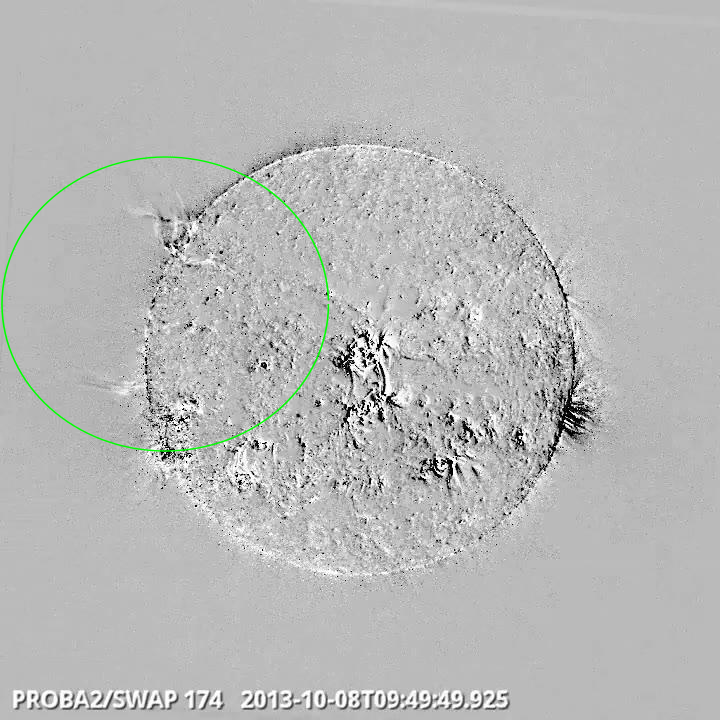
Large scale long duration filament eruption on the east half @ 09:49 - SWAP difference image
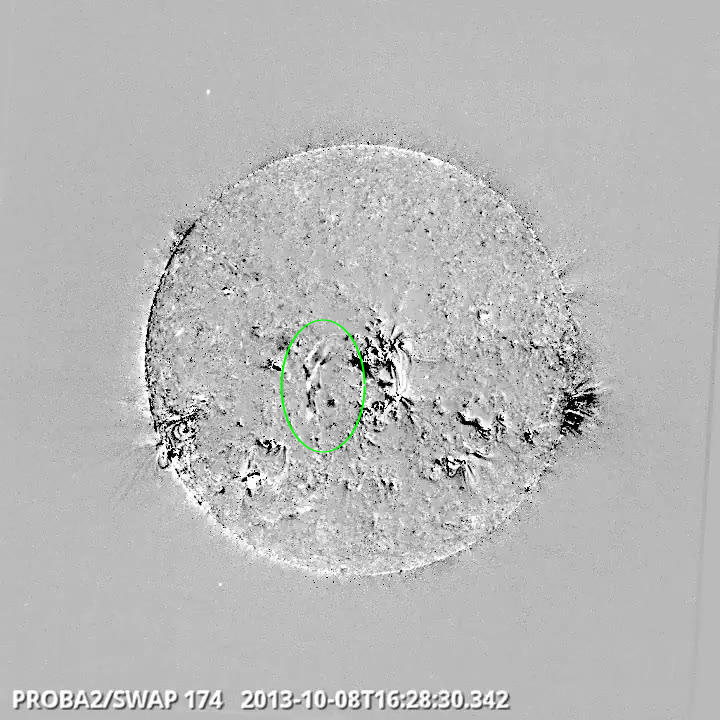
Flow on the south east quad @ 16:28 - SWAP difference image
Find a movie of this event and the large filament eruption shown above this picture here (SWAP
difference movie)
http://proba2.oma.be/swap/data/mpg/movies/WeeklyReportMovies/WR185_Oct07_Oct13/Events/20131008_LargeScaleLongDurationFilamentEruption_East_0949_Flow_SouthEastQuad_1628_swap_diff.mp4
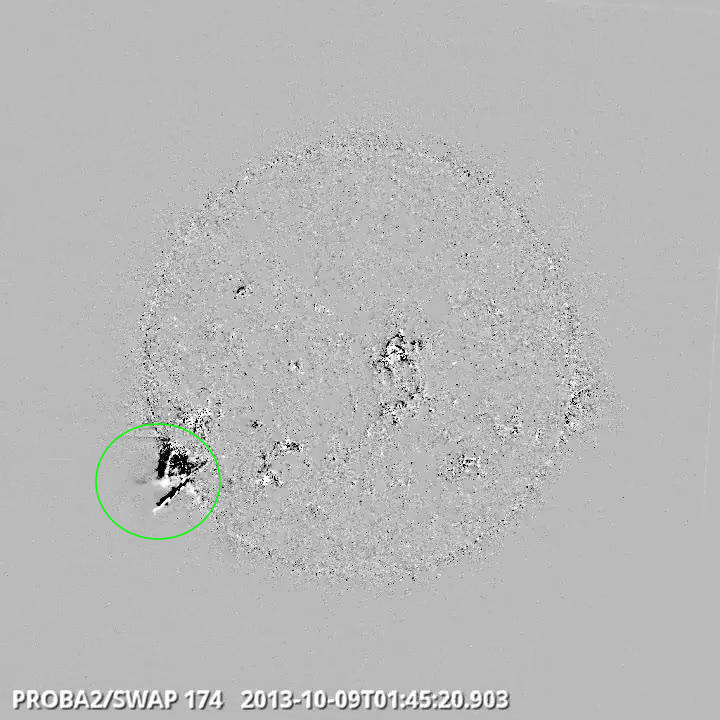
Eruption on south east limb @ 01:45 - SWAP difference image
Find a movie of the complete event here (SWAP difference movie)
http://proba2.oma.be/swap/data/mpg/movies/WeeklyReportMovies/WR185_Oct07_Oct13/Events/20131009_Eruption_SouthEast_0145_swap_diff.mp4
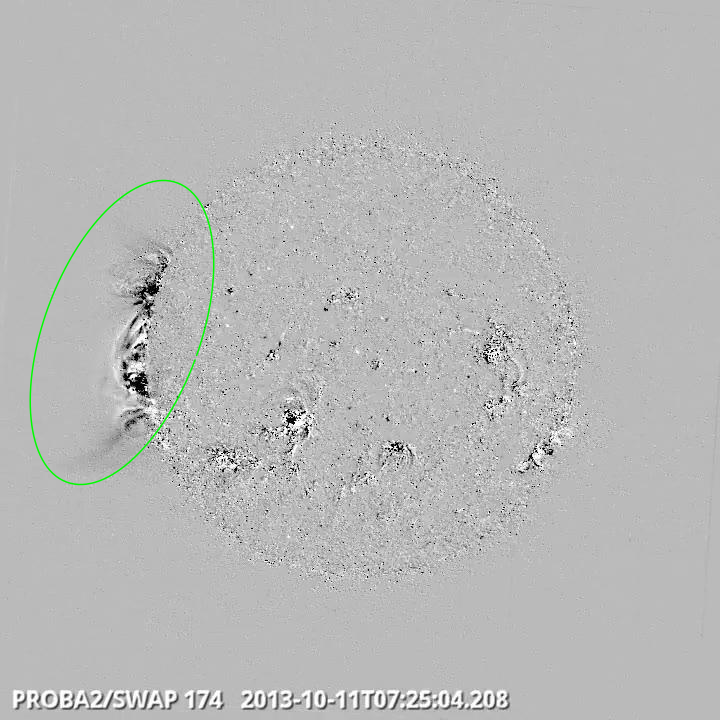
Eruption on east limb @ 07:25 - SWAP difference image
Find a movie of the complete event here (SWAP difference movie)
http://proba2.oma.be/swap/data/mpg/movies/WeeklyReportMovies/WR185_Oct07_Oct13/Events/20131011_Eruption_EastLimb_0725_swap_diff.mp4
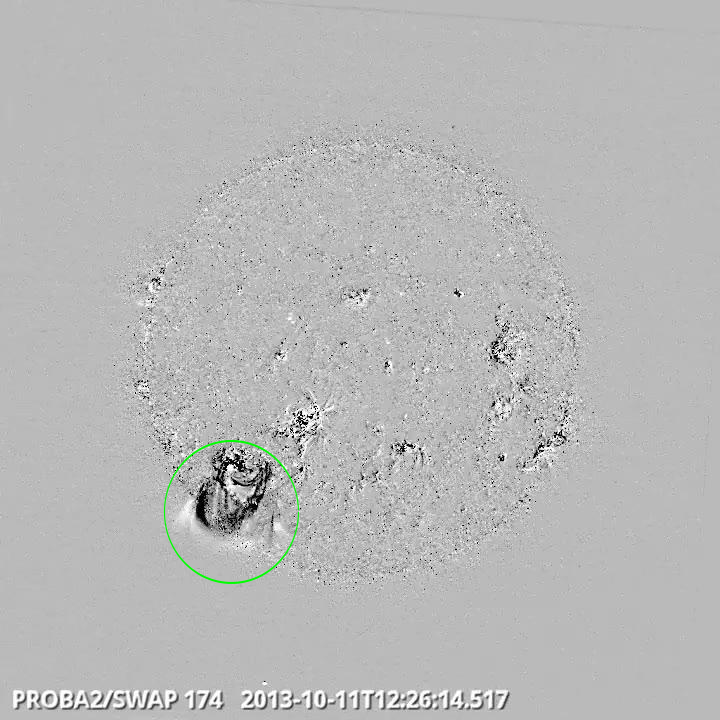
Eruption on south east quad @ 12:26 - SWAP difference image
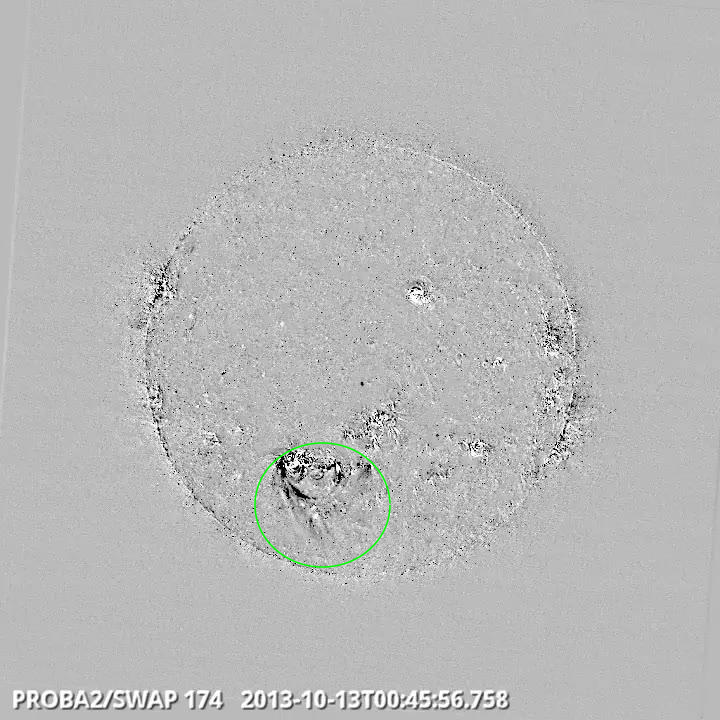
Eruption on south east quad @ 00:45 - SWAP difference image
Find a movie of the complete event here (SWAP difference movie)
http://proba2.oma.be/swap/data/mpg/movies/WeeklyReportMovies/WR185_Oct07_Oct13/Events/20131013_Eruption_SouthEastQuad_0045_swap_diff.mp4
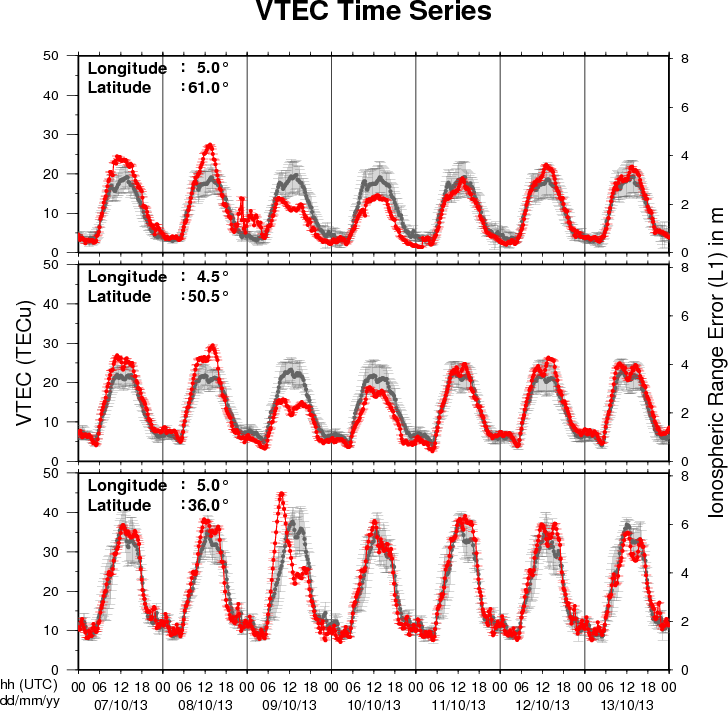
The figure shows the time evolution of the Vertical Total Electron Content (VTEC) (in red) during the last week at three locations:
a) in the northern part of Europe(N61°, 5°E)
b) above Brussels(N50.5°, 4.5°E)
c) in the southern part of Europe(N36°, 5°E)
This figure also shows (in grey) the normal ionospheric behaviour expected based on the median VTEC from the 15 previous days.
The VTEC is expressed in TECu (with TECu=10^16 electrons per square meter) and is directly related to the signal propagation delay due to the ionosphere (in figure: delay on GPS L1 frequency).
The Sun's radiation ionizes the Earth's upper atmosphere, the ionosphere, located from about 60km to 1000km above the Earth's surface.The ionization process in the ionosphere produces ions and free electrons. These electrons perturb the propagation of the GNSS (Global Navigation Satellite System) signals by inducing a so-called ionospheric delay.
See http://stce.be/newsletter/GNSS_final.pdf for some more explanations ; for detailed information, see http://gnss.be/ionosphere_tutorial.php
Start : 2013-10-24 - End : 2013-10-26
Initiated by Profs. Fang and Choudhury, the first Asian-Pacific
Solar Physics Meeting (APSPM) was held in Bangalore two years ago.
During the meeting, a consensus was achieved that it might be a
good idea to have the APSPM every three years. Somehow the second
APSPM was proposed to be held by mainland China in 2013. APSPM is
aimed to exchange the recent research results in solar physics in
the emerging asian-pacific region.
Asian-pacific regions are getting more and more active in solar
physics, as signified by the construction of big facilities,
including the Hinode satellite (Japan), SOXS (India), Chinese Solar
Radio Heliogragh, and Optical & Near-Infrared Solar Eruption
Tracer (ONSET). Therefore, colleagues have agreed to hold regional
solar physics meetings regularly. The first Asian-Pacific Solar
Physics Meeting (APSPM) was held in Bangalore during March 22-24
2011. During the meeting, a consensus was achieved that it might be
a good idea to have the APSPM every three years. Somehow the second
APSPM was proposed to be held by mainland China in 2013. APSPM is
aimed to exchange the recent research results in solar physics in
the emerging asian-pacific region.
Website:
http://sdac.nju.edu.cn/~solar/
Start : 2013-10-27 - End : 2013-10-31
Magnetic helicity has been intensively studied from
observational, theoretical, and many other aspects of solar
physics. For this meeting we would like to invite solar physicists
who are interested in the observational and theoretical studies of
the helicity, to encourage thorough discussions on the relevant hot
issues. The 1st Helicity Thinkshop was held successfully in 2009,
and now the 2nd one will be held on October 27-31, 2013 in Beijing,
China.
Website:
http://sun.bao.ac.cn/meetings/HT2013/
Start : 2013-10-28 - End : 2013-11-02
The Worshop and School on Radio Sun in Beijing and Inner
Mongolia during Oct.28 - Nov. 2, 2013 is the first international
academic seminar supported by the International Research Staff
Exchange Scheme of the Seventh Fromework Programme of the European
Union (FP7-IRSES-295272-RADIOSUN).
The primary aim of this programme is to establish close research
interaction and collaboration between the key research groups
involved in CSRH, SSRT, and ALMA projects and in development of
relevant theory and data analysis tools, through the systematic
research staff and knowledge exchange, joint research efforts
exploiting existing data and facilities, and preparing the future
world-class partnership in exploitation of the upcoming
facilities.
The Workshop and School welcome all solar physicsts and students
who are interested in solar radio astronomy to participate. We will
discuss and exchange the scientific frontier problems, including
the new-generation radio instruments (CSRH, Siberian
multi-frequency radioheliograph, LOFAR, ALMA, and other new
instruments), recent achievements and their scientific goals;
methods and techniques of data processing (for example, software,
radio image reconstructions, and method for studying various types
of solar radio fine structures); and the objectives of new
observational data and new mathematical methods.
Website:
http://beijingradiosun.csp.escience.cn/
Start : 2013-11-11 - End : 2013-11-22
Magnetic fields play an important role in many astrophysical
processes. But magnetic are difficult to detect and to model or
understand, since the fundamental equations describing the behavior
of magnetized plasmas are highly non-linear. Hence, magnetic fields
are often an inconvenient subject which is overlooked or simply
neglected. Such difficulty burdens the research on magnetic fields,
which has evolved to become a very technical subject, with many
small disconnected communities studying specific aspects and
details.
The school tries to amend the situation by providing a unifying
view of the subject. The students would have a chance to understand
the behavior of magnetic fields in all astrophysical contexts, from
cosmology to the Sun. From star-bursting regions to AGNs in
galaxies. The school will present a balanced yet complete review of
our knowledge. Extensions into the unknown are also important to
indicate present and future lines of research.
The Winter School will bring together in a relaxed working
atmosphere a number of the leading scientists in this field, PhD
students and recent postdocs. The conditions for a successful
interaction will be granted, including two special sessions for
those students that want to present their own work.
Website:
http://www.iac.es/winterschool/2013/
Start : 2013-11-12 - End : 2013-11-15
Since its launch in Sep-2006, more than 600 refereed papers have
been published based on Hinode observations, presenting many new
and important findings to the scientific community. However, due to
the unexpectedly low levels of solar activity, until now the focus
has mainly been on the more quiescent aspects of the solar cycle.
With the solar maximum expected this year, through cooperative
observations with SDO, IRIS, and ground based observatories, Hinode
observations should lead to our understanding of active Sun
phenomena, such as solar flares and CMEs, to be greatly improved.
Making Hinode-7 an excellent opportunity to discuss solar activity
in the current solar cycle and the related science through the use
Hinode data, as well as other solar/space weather data. It will
also be interesting to use this meeting to broaden our focus to
include the solar-stellar connection as a means to deepen our
understanding of solar activity.
Momentum is also gaining for Solar-C, which is being developed
as an international collaboration between Japan, US and Europe. To
further discuss this mission, the Solar-C science meeting will be
held on 11-Nov.
Website:
http://www.kwasan.kyoto-u.ac.jp/hinode-7/
Start : 2013-11-13 - End : 2013-11-13
Most space weather occurs due to the Sun's emissions which
can affect the Earth's space environment. Modern society is
ever more dependent upon ground-based & spaceborne technology
which can be vulnerable to space weather. Satellites, GPS, aviation
& the electric power industry are all at risk from this &
hence space weather is now included on the UK's National Risk
Register. It is important to have long-running, continuous
observations for forecasting, nowcasting & for research in
space weather. This public meeting, held during the peak of the 11
year solar cycle, addresses the deficiency in continuous, long-term
observations & how this might be overcome.
Website:
http://www.rmets.org/events/space-weather-importance-observations
Start : 2013-11-18 - End : 2013-11-22
This International CAWSES-II Symposium hosted by SCOSTEP
(Scientific Committee on Solar-Terrestrial Physics) will provide an
excellent opportunity to discuss the scientific accomplishments of
CAWSES-II and look forward to SCOSTEP's future programs at a moment
toward the end of its five-year period. The symposium will cover
the six major themes of CAWSES-II tasks: 1) What are the solar
influences on the Earth's climate?, 2) How will geospace respond to
an altered climate?, 3) How does short-term solar variability
affect the geospace environment?, 4) What is the geospace response
to variable inputs from the lower atmosphere?, 5) Capacity
Building, 6) Informatics and eScience. The main functions of
CAWSES-II are to help coordinate international activities in
observations, modeling, and applications crucial to achieving this
understanding, to involve scientists in both developed and
developing countries, and to provide educational opportunities for
students of all levels. The symposium offers keynotes/lectures that
will be interesting for all participants every morning and more
specific sessions of presentations in the afternoon. We welcome all
those who are involved and/or interested in CAWSES-II to Nagoya in
the autumn when we will have the pleasure of being surrounded by
beautiful colorful leaves of this season.
Website:
http://www.cawses.org/CAWSES/leaflet_CAWSES-II_120229.pdf
Start : 2013-11-18 - End : 2013-11-22
The 10th Edition of the European Space Weather
Week will take place on 18-22nd
November 2013 in Belgium. The venue will be confirmed early next
year, but mark your calendars now for the 10th Anniversary of this
growing European event.
The ESWW will again adopt the central aim of bringing together
the diverse groups in Europe working on different aspects of Space
Weather
. This includes but isn't
limited to the scientific community, the engineering community,
applications developers, service providers and service end users.
The meeting organisation will again be coordinated by the Belgian
Solar-Terrestrial Centre of Excellence (STCE), ESA
and the Space Weather
Working Team. The local
organisation will be done by the STCE.
Website:
http://www.stce.be/esww10/
Start : 2013-11-26 - End : 2013-11-28
The 1st SPRING (Solar Physics Research Integrated Network Group)
workshop is being held from November 26 - 28, 2013 at the scenic
Brugger's Hotel Park by Titisee hosted by the Kiepenheuer-Institut
für Sonnenphysik in Freiburg, Germany.
The purpose of the workshop is to work on the scientific
requirements for a new ground-based network of telescopes for
full-disk synoptic observations of the Sun.
The desire for such a new network is motivated by new scientific
research directions in solar physics, the requirement of real-time
context data for high-resolution solar telescopes, and the need of
continuous, long-term, consistent, and reliable solar data as
foundation for space weather prediction.
Website:
http://www3.kis.uni-freiburg.de/~mroth/spring.html
Start : 2013-12-13 - End : 2013-12-13
The inclusion of space weather in the National Risk Assessment
in 2012 means that there is now an urgent need for dialogue between
those doing the science of space weather and those using the data
to forecast, understand and mitigate the risks.
Since the Sun is currently at the peak of its cycle - a time
when space weather events become more frequent - we have a timely
opportunity to study how a range of solar activity ultimately lead
to magnetospheric, ionospheric and ground level disturbances.
The goal of this meeting is to bring together those working
across the broad range of space weather activities in the UK to
discuss the current status of observations and recent new advances
in the theories and models of the phenomena of space weather.
Website:
http://www.mssl.ucl.ac.uk/~lmg/spaceweather/Overview.html
Start : 2014-03-16 - End : 2014-03-22
The meeting brings together scientists working in solar physics,
space physics, plasma physics, and astrophysics, in theory,
simulations, and experiment. The objective is to report and discuss
recent progress in our understanding of the fundamental processes
in solar, space, and astrophysical plasmas, in view of heliospheric
in-situ and remote sensing measurements (Van Allen Probe, Themis,
Cluster, Stereo, SDO, Messenger, Cassini, Venus-Express) and remote
sensing astrophysical observations (Chandra, XMM-Newton, Swift and
Fermi Gamma-ray Telescope).
Website:
http://physics.bgu.ac.il/~gedalin/Isradynamics2014/
Start : 2014-06-23 - End : 2014-06-27
The meeting in honour of Prof. Zdenek Svestka will cover issues
of the physics of solar and stellar flares.
Website:
http://solarflares2014.cz/
Start : 2014-08-02 - End : 2014-08-10
The 40th COSPAR Scientific Assembly will be held in Moscow,
Russia from 2 - 10 August 2014. This Assembly is open to all bona
fide scientists.
Website:
http://www.cospar-assembly.org/
Start : 2014-08-31 - End : 2014-09-05
Low-frequency waves (ULF, ELF and VLF) in space plasmas have
been studied for many decades. In our solar system, such waves
occur in the magnetospheres of planets and in the solar wind; more
recently they have also been confirmed on the Sun. In spite of the
great differences in the plasma properties of these regions, the
overarching schemes are wave generation, wave propagation, and wave
dissipation, which are three fundamental aspects of any kind of
waves. A fourth aspect of these waves is their application, either
with direct benefit to humans or for scientific pursuit. Therefore,
this Chapman conference will provide a forum in which various wave
communities can come together and discuss recent achievements of
observational, theoretical, and modeling studies.
Website:
http://chapman.agu.org/spaceplasmas/
Start : 2014-09-08 - End : 2014-09-12
The European Solar Physics Meetings aim to highlight all aspects
of modern solar physics, including observation and theory that span
from the interior of the Sun out into the wider heliosphere. These
meetings provide a broad, yet stimulating, environment for European
and international scientists to share their research in solar
physics.
The meeting will mostly comprise of contributed talks and poster
presentations, with several invited review talks (typically one per
session). Posters will be on display for the whole meeting in close
proximity to the lecture theatre. Refreshments will be served in
the poster viewing area during two dedicated coffee/poster breaks
on each full day.
Website: http://www.espm14.ie/
Start : 2015-06-22 - End : 2015-06-26
The Fourteenth International Solar Wind Conference will be held
for the first time ever in China, from 22 to 26 June 2015, at
Weihai in the Shandong province. It will be jointly organized by
the School of Earth and Space Sciences of Peking University and the
newly-established Institute of Space Sciences of Shandong
University. The meeting will take place in the Space Science
Building of Shandong University, a venue located within walking
distance to the beautiful Weihai International Bathing Beach, one
of the most popular scenic areas of northern China.
The conference will cover all aspects of solar wind physics,
with invited reviews and contributed papers that examine the
current research and outline the future research in all the
relevant solar wind fields.
Website: not available yet